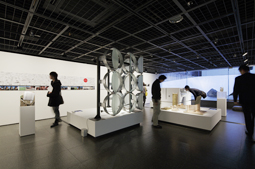 |
|
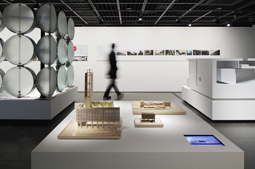 |
Sean Godsell's full-size facade detail mockup for the Royal Melbourne Institute of Technology Design Hub is the centerpiece on the main floor of Toto Gallery MA.
|
|
Kerry Hill's delicate wood models of modern buildings influenced by the tropical Asian vernacular. |
To mark the 25th anniversary of its founding, Gallery MA, a Tokyo design and architecture mainstay, was renamed Toto Gallery MA and has launched a commemorative exhibition, Global Ends: Towards the Beginning. A committee comprised of five notable Japanese architects (with Tadao Ando serving as special advisor) was established to select the exhibitors. After considering dozens of candidates, the committee chose seven architectural practices from around the world that seem to embody the global zeitgeist: Paulo David of Madeira, Portugal; Sean Godsell of Melbourne, Australia; Kerry Hill of Singapore; Junya Ishigami of Tokyo; Tom Kundig of Seattle, USA; Smiljan Radic of Santiago, Chile; and RCR Adanda Pigem Vilalta Arquitectes of Olot, Spain. Although these seven practices have very different approaches, what they share is a heightened sensitivity to the local regions, cultures, and environments where they work.
Ken Tadashi Oshima, the venerable architecture historian and University of Washington professor, was invited to be the exhibition's guest curator. He posed four questions to each practitioner: 1) How has your practice been affected by 9/11 [September 11, 2001] and where were you on 9/11? 2) How would you define architecture in your practice? 3) What five words would you use to describe your practice? 4) What risks do you take in architecture? Their answers and work reveal that major global events can affect even the smallest practice, and that shared common values are found on every continent. (A printed transcript of their complete answers may be obtained through Toto Gallery MA).
When asked what risks he takes in architecture, Sean Godsell of Melbourne said, ". . . to paraphrase Bernard Tschumi, 'to follow the first rule of architecture, you must break it.' Architecture is risk, by definition." Godsell is known for his (often literally) dynamic facades that are able to open and close upon themselves. Drawing visitors into the exhibit space is a full-size facade detail mockup for the Royal Melbourne Institute of Technology Design Hub, currently under construction. Diminutive accompanying sketches fill all of the wall space he is given, roughly aligned with their respective project photos. Like a mini-retrospective of his work, they depict how deeply Godsell thinks about details and tectonics.
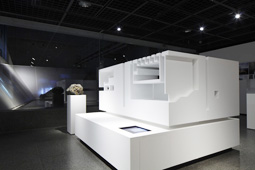 |
|
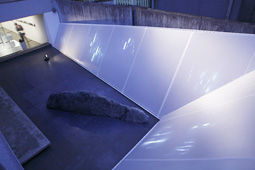 |
A model of Paolo David's Casa das Mudas Arts Centre and a piece of basalt from its site on the cliffs of Madeira Island.
|
|
The architects' quotes are projected onto a large sloping screen in English and Japanese, tying the ensemble together.
|
Singapore-based architect Kerry Hill said of his firm's approach to risk, ". . . we like to contemporize our understanding of how a material might be used and it doesn't always work, that is a risk." His work demonstrates a thoughtful complexity without being overly complicated. A broad, low platform displays his intricate, understated wood models. Conscious of the climate and the vernacular architecture found deep in the tropical Asian context, he employs masonry and wood with a judicious use of water features in a number of projects. Hill says, "I like to think of our buildings as being current, but filtered through a sieve of traditional values."
No stranger to extreme landscapes, architect Paolo David enjoys cutting and carving as demonstrated by the massive model of Casa das Mudas Arts Centre. Located on the basalt cliffs of Madeira Island, the building itself is also clad in basalt, making it appear partially buried and partially sculpted. When asked how he would define architecture in his practice, David responds, "We work in a balance between considerations of the territory and a desire to fulfill a proposed program -- between the dimensions of the landscape and the architectural object . . ." A piece of Madeira basalt is displayed next to the model, highlighting David's respect for material and context.
Well known in his home of Chile, Smiljan Radic is just starting to receive international attention (he was made an Honorary Fellow of the American Institute of Architects in 2009 and represented Chile at the 2010 Venice Architecture Biennale). Although his work is unmistakably modern and crisp, he draws inspiration from the regional vernacular, such as simple Chilean houses. Radic says, "I have never understood what architecture means. I simply work to the best of my ability projecting ideas and constructions. I prefer the word construction. It's more agile, less solemn, and so requires less definition." A sculptural wooden model is on display; entitled Refuge, its supplemental drawings are loose and timely.
A highlight of the exhibition is Human Naturalization, a lifesized, X-ray-like image of a man and woman walking nude. It is a fitting representation of how RCR Aranda Pigem Vilalta Arquitectes define architecture, ". . . the art of materializing dreams along a long distance journey." A play of transparency appears regularly in the Spanish firmfs work, as does the repetitive use of linear elements to create rich, high-contrast spaces.
Known best for his ethereal intervention, the KAIT Workshop at Kanagawa Institute of Technology, Junya Ishigami is quickly becoming a rising star in Japan. A man of few words, his responses to the interview questions are vague. Question: "How do you define architecture in your practice?" Answer: "It is difficult -- indefinable." Question: "What five words would you use to describe your practice?" Answer: "It is difficult to analyze my work appropriately in five words." By far the youngest among these practitioners, perhaps with more experience Ishigami will be better able to articulate his methodology. On display is a 1:5-scale structural frame for his project on the boards, House of Garden & Terrace.
Hot Rod by Tom Kundig of Olson Kundig Architects in Seattle, Washington is the exhibition's pièce de résistance. The interactive series of movable panels and sculptures beg to be touched. At times rough and nostalgic, his work can also be described as precise and unfettered. Twelve monitors display aerial photos of each project site that zoom in and out of scale, a simple but mesmerizing technique. Kundig is known for creating tactile, place-conscious architecture that features mechanically inventive custom hardware. On taking risks, Kundig says, "If you step outside of that common denominator, you're clearly risking something -- not necessarily life or limb -- but you're risking function, you're risking aesthetics -- and I think that's why risk taking makes life interesting."
The architects' answers to the questions posed by the curator are projected onto a large sloping screen that envelops the gallery's courtyard, engaging visitors and holding the ensemble together. Even if the visitor has never been to Spain, Chile, Singapore, Seattle, Melbourne or Madeira, a regional response is intuitively understood and appreciated over universal homogeneity. Global Ends: Towards the Beginning celebrates seven architectural risk-takers who subtly draw from their local environs while informing the broader world in which we live.
 |
|
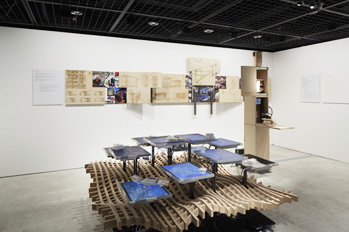 |
Human Naturalization by RCR Aranda Pigem Vilalta Arquitectes, who define architecture as "the art of materializing dreams along a long distance journey."
|
|
Tom Kundig's Hot Rod, an interactive series of movable panels and sculptures that beg to be touched.
All photos ©Nacása & Partners Inc. |
|